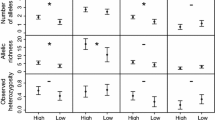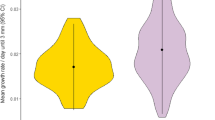Abstract
Biological invasions can promote secondary contacts between related species and thus provide excellent case studies for investigating the joint ecological and evolutionary trajectories of interfertile taxa. Here, we studied two tunicates living in sympatry, and sometimes in syntopy, in the English Channel, Ciona intestinalis species A (presumed native to the NW Pacific) and species B (native to the N Atlantic). In addition to monitoring their co-existence over time, we examined the level of interspecific gene flow, a process that may increase the invasiveness of the non-native species. The sampling scheme was repeated twice a year for 3 years (six distinct generations) to determine the relative abundance of the two species in 11 localities along the coasts of the English Channel and the Iroise Sea (covering 1600 km) in Brittany, France. We examined 23,000 individuals, including 5315 specimens for which reproductive status was determined. Four species-diagnostic molecular markers traced interspecific gene flow on a random subset of 3048 individuals. Regardless of the sampling date, the two species co-occurred in most of the study sites, with species A showing higher frequency in the autumn. The regional pattern of seasonal variation in relative abundance of the two congeners appears to correspond to different thermal growth optima. Abrupt variations in environmental parameters can act synergistically and may favor the non-native species locally. Despite syntopy, synchronous gamete production and successful in vitro interspecific crosses, only 4.3 % individuals showed an admixed genome (i.e. footprint of present-day or past introgression events), most of them with a species A maternal lineage, of which only one was a putative first generation hybrid. Altogether, efficient barriers seem to prevent interspecific crosses between the two interfertile congeners in the wild: present-day hybridization may have less impact than competitive interactions on the fate of the two study species over their sympatric range.





Similar content being viewed by others
References
Abbott RJ (1992) Plant invasion, interspecific hybridization and the evolution of new plant taxa. Trends Ecol Evol 7:401–405
Abbott R, Albach D, Ansell S et al (2013) Hybridization and speciation. J Evol Biol 26:229–246
Airoldi L, Turon X, Perkol-Finkel S et al (2015) Corridors for aliens but not for natives: effects of marine urban sprawl at a regional scale. Divers Distrib 21:755–768
Allendorf FW, Leary RF, Spruell P et al (2001) The problems with hybrids: setting conservation guidelines. Trends Ecol Evol 16:613–622
Alpert P (2006) The advantages and disadvantages of being introduced. Biol Invasions 8:1523–1534
Bates D, Maechler M, Bolker B et al (2014) lme4: linear mixed-effects models using Eigen and S4. R package version 1.1-7. http://CRAN.R-project.org/package=lme4
Becquet V, Simon-Bouhet B, Pante E et al (2012) Glacial refugium versus range limit: conservation genetics of Macoma balthica, a key species in the Bay of Biscay (France). J Exp Mar Biol Ecol 432–433:73–82
Bierne N, David P, Boudry P et al (2002) Assortative fertilization and selection at larval stage in the mussels Mytilus edulis and M. galloprovincialis. Evolution 56:292–298
Bishop JDD, Wood CA, Lévêque L et al (2015) Repeated rapid assessment surveys reveal contrasting trends in occupancy of marinas by non-indigenous species on opposite sides of the western English Channel. Mar Pollut Bull 95:699–706
Blackburn TM, Essl F, Evans T et al (2014) A unified classification of alien species based on the magnitude of their environmental impacts. PLoS Biol. doi:10.1371/journal.pbio.1001850
Blum MJ, Walters DM, Burkhead NM et al (2010) Reproductive isolation and the expansion of an invasive hybrid swarm. Biol Invasions 12:2825–2836
Bock DG, MacIsaac HJ, Cristescu ME (2012) Multilocus genetic analyses differentiate between widespread and spatially restricted cryptic species in a model ascidian. Proc R Soc B 279:2377–2385
Borsa P, Rolland V, Daguin C (2012) Genetics and taxonomy of Chilean smooth-shelled mussels, Mytilus spp. (Bivalvia: Mytilidae). C R Biol 335:51–61
Brunetti R, Gissi C, Pennati R et al (2015) Morphological evidence that the molecularly determined Ciona intestinalis type A and type B are different species: Ciona robusta and Ciona intestinalis. J Zool Syst Evol Res 53:186–193
Caputi L, Andreakis N, Mastrototaro F et al (2007) Cryptic speciation in a model invertebrate chordate. Proc Natl Acad Sci USA 104:9364–9369
Caputi L, Crocetta F, Toscano F et al (2014) Long-term demographic and reproductive trends in Ciona intestinalis sp. A. Mar Ecol 36:118–128
Carver CE, Chisholm A, Mallet AL (2003) Strategies to mitigate the impact of Ciona intestinalis (L.) biofouling on shellfish production. J Shellfish Res 22:621–631
Cirino P, Toscano F, Caramiello D et al (2002) Laboratory culture of the ascidian Ciona intestinalis (L.): a model system for molecular developmental biology research. Mar Models Electron Rec. http://www.mbl.edu/html/BB/MMER/CIR/CirTit.html
Coleman RR, Gaither MR, Kimokeo B et al (2014) Large-scale introduction of the Indo-Pacific damselfish Abudefduf vaigiensis into Hawai’i promotes genetic swamping of the endemic congener A. abdominalis. Mol Ecol 23:5552–5565
Currat M, Ruedi M, Petit RJ et al (2008) The hidden side of invasions: massive introgression by local genes. Evolution 62:1908–1920
Dybern BI (1965) The life cycle of Ciona intestinalis (L.) f. typica in relation to the environmental temperature. Oikos 16:109–131
Fitzpatrick BM, Johnson JR, Kump DK et al (2010) Rapid spread of invasive genes into a threatened native species. Proc Natl Acad Sci USA 107:3606–3610
Gallon RK, Robuchon M, Leroy B et al (2014) Twenty years of observed and predicted changes in subtidal red seaweed assemblages along a biogeographical transition zone: inferring potential causes from environmental data. J Biogeogr 41:2293–2306
Geller JB, Darling JA, Carlton JT (2010) Genetic perspectives on marine biological invasions. Annu Rev Mar Sci 2:367–393
Geyer LB, Palumbi SR (2005) Conspecific sperm precedence in two species of tropical sea urchins. Evolution 59:97–105
Guo Q (2014) Plant hybridization: the role of human disturbance and biological invasion. Divers Distrib 20:1345–1354
Harrison RG (2012) The language of speciation. Evolution 66:3643–3657
Lambert CC, Lambert G (1998) Non-indigenous ascidians in southern California harbors and marinas. Mar Biol 130:675–688
Maggs CA, Castilho R, Foltz D et al (2008) Evaluating signatures of glacial refugia for North Atlantic benthic marine taxa. Ecology 89:S108–S122
Mantel N (1963) Chi square tests with one degree of freedom: extensions of the Mantel-Haenszel Procedure. J Am Stat Assoc 58:690–700
Marin MG, Bressan M, Beghi L et al (1987) Thermo-haline tolerance of Ciona intestinalis (L., 1767) at different developmental stages. Cah Biol Mar 28:47–57
Millar RH (1953) Ciona. In: Colman JS (ed) LMBC memoirs of typical British marine plants and animals, XXV. Liverpool University Press, Liverpool, pp 123
Molnar JL, Gamboa RL, Revenga C et al (2008) Assessing the global threat of invasive species to marine biodiversity. Front Ecol Environ 6:485–492
Nydam ML, Harrison RG (2007) Genealogical relationships within and among shallow-water Ciona species (Ascidiacea). Mar Biol 151:1839–1847
Nydam ML, Harrison RG (2010) Polymorphism and divergence within the ascidian genus Ciona. Mol Phylogenet Evol 56:718–726
Nydam ML, Harrison RG (2011) Introgression despite substantial divergence in a broadcast spawning marine invertebrate. Evolution 65:429–442
Ouzeau G, Déqué M, Jouini M et al (2014) Scénarios régionalisés - édition 2014 - pour la métropole et les régions d’outre-mer. In: Jouzel J (ed) Le climat de la France au XXIe siècle. Direction Générale de l’Energie et du Climat 4, p 62
Palumbi SR (1994) Genetic divergence, reproductive isolation and marine speciation. Annu Rev Ecol Syst 25:547–572
Perez-Portela R, Arranz V, Rius M et al (2013) Cryptic speciation or global spread? The case of a cosmopolitan marine invertebrate with limited dispersal capabilities. Sci Rep. doi:10.1038/srep03197
Petersen JK, Schou O, Thor P (1995) Growth and energetics in the ascidian Ciona intestinalis. Mar Ecol Prog Ser 120:175–184
Procaccini G, Affinito O, Toscano F et al (2011) A new animal model for merging ecology and evolution. In: Pontarotti P (ed) Evolutionary biology: concepts, biodiversity, macroevolution and genome evolution. Springer, Berlin, pp 91–106
Rawson PD, Slaughter C, Yund PO (2003) Patterns of gamete incompatibility between the blue mussels Mytilus edulis and M. trossulus. Mar Biol 143:317–325
R Development Core Team (2005) R: a language and environment for statistical computing. R Foundation for Statistical, Vienna, Austria. ISBN: 3-900051-07-0. http://www.R-project.org
Rhymer JM, Simberloff D (1996) Extinction by hybridization and introgression. Annu Rev Ecol Syst 27:83–109
Rius M, Heasman KG, McQuaid CD (2011) Long-term coexistence of non-indigenous species in aquaculture facilities. Mar Pollut Bull 62:2395–2403
Rosenfield JA, Nolasco S, Lindauer S et al (2004) The role of hybrid vigor in the replacement of Pecos pupfish by its hybrids with sheepshead minnow. Conserv Biol 18:1589–1598
Roux C, Tsagkogeorga G, Bierne N et al (2013) Crossing the species barrier: genomic hotspots of introgression between two highly divergent Ciona intestinalis species. Mol Biol Evol 30:1574–1587
Sato A, Satoh N, Bishop JDD (2012) Field identification of ‘types’ A and B of the ascidian Ciona intestinalis in a region of sympatry. Mar Biol 159:1611–1619
Sato A, Shimeld SM, Bishop JDD (2014) Symmetrical reproductive compatibility of the two species in the Ciona intestinalis (Acidiacea) species complex, a model for marine genomics and developmental biology. Zool Sci 31:369–374
Schierenbeck KA, Ellstrand NC (2009) Hybridization and the evolution of invasiveness in plants and other organisms. Biol Invasions 11:1093–1105
Shenkar N, Swalla BJ (2011) Global diversity of Ascidiacea. PLoS ONE. doi:10.1371/journal.pone.0020657
Simberloff D, Stiling P (1996) How risky is biological control? Ecology 77:1965–1974
Steeves TE, Maloney RF, Hale ML, Tylianakis JM et al (2010) Genetic analyses reveal hybridization but no hybrid swarm in one of the world’s rarest birds. Mol Ecol 19:5090–5100
Suzuki MM, Nishikawa T, Bird A (2005) Genomic approaches reveal unexpected genetic divergence within Ciona intestinalis. J Mol Evol 61:627–635
Svane I, Havenhand JN (1993) Spawning and dispersal in Ciona intestinalis (L.). Mar Ecol 14:53–66
Zhan A, Macisaac HJ, Cristescu ME (2010) Invasion genetics of the Ciona intestinalis species complex: from regional endemism to global homogeneity. Mol Ecol 19:4678–4694
Acknowledgments
We are very grateful to the divers of the Marine Operations Department (Service Mer and Observation) at the Roscoff Biological Station for help in the field and to M. Danielo for assistance in data acquisition. FV thanks M. Nydam for her recommendations regarding molecular protocols. We are thankful for the numerous marina operators who provided access to pontoons and permission to carry out this study. We acknowledge S. Le Cam and T. Broquet for advices regarding statistical analyses, N. Bierne for stimulating discussions about hybridization and introgression processes, and C. Lejeusne and T. Comtet for comments on earlier versions of this manuscript. This work was supported by the Interreg IVa Marinexus program and the ANR Project HYSEA (No. ANR-12-BSV7-0011).
Author information
Authors and Affiliations
Corresponding authors
Electronic supplementary material
Below is the link to the electronic supplementary material.
Rights and permissions
About this article
Cite this article
Bouchemousse, S., Lévêque, L., Dubois, G. et al. Co-occurrence and reproductive synchrony do not ensure hybridization between an alien tunicate and its interfertile native congener. Evol Ecol 30, 69–87 (2016). https://doi.org/10.1007/s10682-015-9788-1
Received:
Accepted:
Published:
Issue Date:
DOI: https://doi.org/10.1007/s10682-015-9788-1




